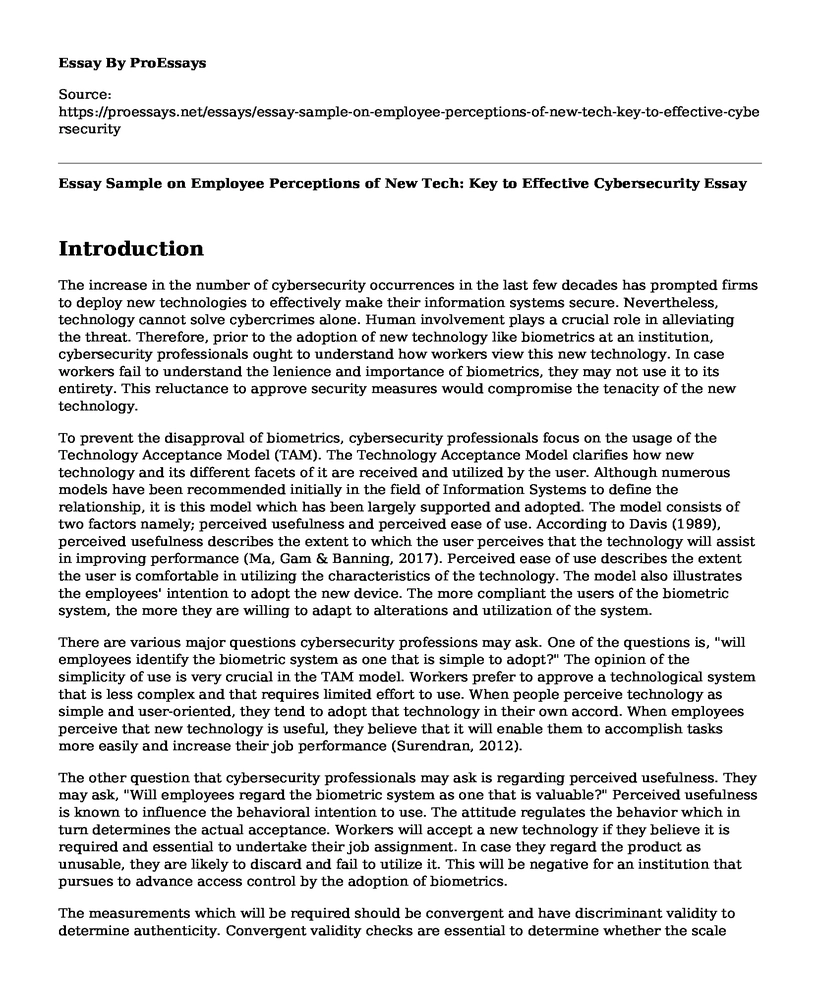Introduction
The increase in the number of cybersecurity occurrences in the last few decades has prompted firms to deploy new technologies to effectively make their information systems secure. Nevertheless, technology cannot solve cybercrimes alone. Human involvement plays a crucial role in alleviating the threat. Therefore, prior to the adoption of new technology like biometrics at an institution, cybersecurity professionals ought to understand how workers view this new technology. In case workers fail to understand the lenience and importance of biometrics, they may not use it to its entirety. This reluctance to approve security measures would compromise the tenacity of the new technology.
To prevent the disapproval of biometrics, cybersecurity professionals focus on the usage of the Technology Acceptance Model (TAM). The Technology Acceptance Model clarifies how new technology and its different facets of it are received and utilized by the user. Although numerous models have been recommended initially in the field of Information Systems to define the relationship, it is this model which has been largely supported and adopted. The model consists of two factors namely; perceived usefulness and perceived ease of use. According to Davis (1989), perceived usefulness describes the extent to which the user perceives that the technology will assist in improving performance (Ma, Gam & Banning, 2017). Perceived ease of use describes the extent the user is comfortable in utilizing the characteristics of the technology. The model also illustrates the employees' intention to adopt the new device. The more compliant the users of the biometric system, the more they are willing to adapt to alterations and utilization of the system.
There are various major questions cybersecurity professions may ask. One of the questions is, "will employees identify the biometric system as one that is simple to adopt?" The opinion of the simplicity of use is very crucial in the TAM model. Workers prefer to approve a technological system that is less complex and that requires limited effort to use. When people perceive technology as simple and user-oriented, they tend to adopt that technology in their own accord. When employees perceive that new technology is useful, they believe that it will enable them to accomplish tasks more easily and increase their job performance (Surendran, 2012).
The other question that cybersecurity professionals may ask is regarding perceived usefulness. They may ask, "Will employees regard the biometric system as one that is valuable?" Perceived usefulness is known to influence the behavioral intention to use. The attitude regulates the behavior which in turn determines the actual acceptance. Workers will accept a new technology if they believe it is required and essential to undertake their job assignment. In case they regard the product as unusable, they are likely to discard and fail to utilize it. This will be negative for an institution that pursues to advance access control by the adoption of biometrics.
The measurements which will be required should be convergent and have discriminant validity to determine authenticity. Convergent validity checks are essential to determine whether the scale items measure a universal fundamental concept. Discriminant validity distinguishes between the items that are being computed. To assess convergent and discriminant rationalities, a Multitrait-Multimethod matrix is utilized. This approach assesses the construct validity of a set of measures in a study (Jones, McCarthy, Halawi & Mujtaba, 2010). It offers a practical methodology that scholars could use.
References
Jones, C. M., McCarthy, R. V., Halawi, L., & Mujtaba, B. (2010). Utilizing the technology acceptance model to assess the employee adoption of information systems security measures. Issues in Information Systems, 11(1), 9. Retrieved from: https://commons.erau.edu/cgi/viewcontent.cgi?referer=https://scholar.google.com/&httpsredir=1&article=1354&context=publication
Ma, Y. J., Gam, H. J., & Banning, J. (2017). Perceived ease of use and usefulness of sustainability labels on apparel products: application of the technology acceptance model. Fashion and Textiles, 4(1), 3. Retrieved from: https://link.springer.com/article/10.1186/s40691-017-0093-1
Surendran, P. (2012). Technology acceptance model: A survey of the literature. International Journal of Business and Social Research, 2(4), 175-178. DOI: http://dx.doi.org/10.18533/ijbsr.
Cite this page
Essay Sample on Employee Perceptions of New Tech: Key to Effective Cybersecurity. (2023, Feb 12). Retrieved from https://proessays.net/essays/essay-sample-on-employee-perceptions-of-new-tech-key-to-effective-cybersecurity
If you are the original author of this essay and no longer wish to have it published on the ProEssays website, please click below to request its removal:
- Essay Sample on How Data Clustering Affects Accounting
- Essay Example on Robust IT Systems: A Necessity for Business Entities
- Comparison of Data Visualization Tools and Programming for Data Analytics
- The Digital Revolution: Connecting Billions of Objects and Devices - Essay Sample
- Organizational Cyber Resilience: Protecting Against Data Breaches and Cyberattacks - Essay Sample
- Paper Sample on Effective Management Policies: Cert Revocation Lists, Cert Auth & Digital Certs
- Virtual Site Visit - Free Essay Sample







